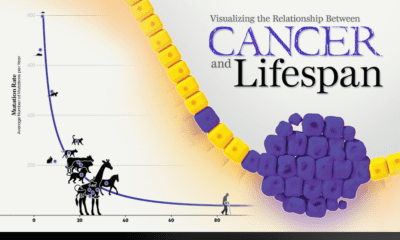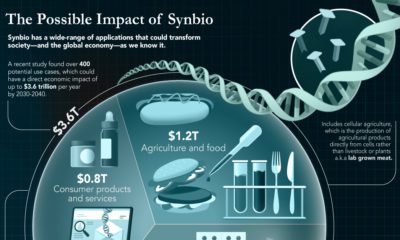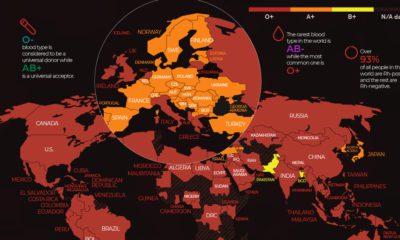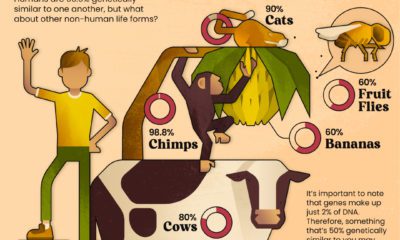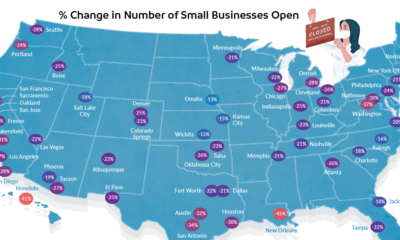Humanity has been tinkering with natural life for thousands of years. We’ve become remarkably good at it, too—to date, we’ve modified bacteria to produce drugs, created crops with built-in pesticides, and even made a glow-in-the-dark dog. However, despite our many achievements in the realm of genetic engineering, one thing we’re still working on is bringing extinct animals back to life. But scientists are working on it. In fact, there’s a whole field of biology that’s focused on reviving extinct species. This graphic provides a brief introduction to the fascinating field of science known as resurrection biology—or de-extinction.
The Benefits of De-Extinction
First thing’s first—what is the point of bringing back extinct animals?
There are a number of research benefits that come with de-extinction. For instance, some scientists believe studying previously extinct animals and looking at how they function could help fill some gaps in our current theories around evolution.
De-extinction could also have a beneficial impact on the environment. That’s because when an animal goes extinct, its absence has a ripple effect on all the flora and fauna involved in that animal’s food web.
Because of this, reintroducing previously extinct species back into their old ecosystems could help rebalance and restore off-kilter environments.
There’s even a possibility that de-extinction could slow down global warming. Scientist Sergey Zimov believes that, if we were to reintroduce an animal that’s similar to the woolly mammoth back to the tundra, it could help repopulate the area, regrow ancient plains, and possibly slow the melting of the ice caps.
How Does it Work?
The key element that’s needed to re-create a species is its DNA. Unfortunately, DNA slowly degrades, and once it’s gone completely, there’s no way to recover it. Researchers believe DNA has a half-life of 521 years, so after 6.8 million years, it’s believed to be completely gone. That’s why species like dinosaurs have virtually no chance of de-extinction. However, many organisms that went extinct more recently, like the dodo, could have a chance of conservation. When it comes to de-extinction, there are three main techniques:
① Cloning
This is the only way to create an exact DNA replica of something. However, a complete genome is needed for this, so this form of genetic rescue is most effective with recently-lost species, or species that are nearing extinction.
② Genome Editing
Genome editing is the manipulation of DNA to mimic extinct DNA. There are several ways to do this, but in general, the process involves researchers manipulating the genomes of living species to make a new species that closely resembles an extinct one. Because it’s not an exact copy of the extinct species’ DNA, this method will create a hybrid species that only resembles the extinct animal.
③ Back-Breeding
A form of breeding where a distinguishing trait from an extinct species (a horn or a color pattern) is bred back into living populations. This requires the trait to still exist in some frequency in similar species, and the trait is selectively bred back into popularity. Like genome editing, this method does not resurrect an extinct species, but resurrects the DNA and genetic diversity that gave the extinct species a distinguishing trait.
Is Bringing Back Extinct Animal Species Really Worth it?
While there’s a ton of buzz and potential around the idea of bringing back extinct animal species, there are a few critics that believe our efforts would be better spent on other things. Research on the economics of de-extinction found that the money would go farther if it was invested into conservation programs for living species—approximately two to eight times more species could be saved if invested in existing conversation programs. In an article in Science, Joseph Bennett, a biologist at Carleton University in Ottawa, said “if [a] billionaire is only interested in bringing back a species from the dead, power to him or her.” Bennett added, “however, if that billionaire is couching it in terms of it being a biodiversity conservation, then that’s disingenuous. There are plenty of species out there on the verge of extinction now that could be saved with the same resources.” on Even while political regimes across these countries have changed over time, they’ve largely followed a few different types of governance. Today, every country can ultimately be classified into just nine broad forms of government systems. This map by Truman Du uses information from Wikipedia to map the government systems that rule the world today.
Countries By Type of Government
It’s important to note that this map charts government systems according to each country’s legal framework. Many countries have constitutions stating their de jure or legally recognized system of government, but their de facto or realized form of governance may be quite different. Here is a list of the stated government system of UN member states and observers as of January 2023: Let’s take a closer look at some of these systems.
Monarchies
Brought back into the spotlight after the death of Queen Elizabeth II of England in September 2022, this form of government has a single ruler. They carry titles from king and queen to sultan or emperor, and their government systems can be further divided into three modern types: constitutional, semi-constitutional, and absolute. A constitutional monarchy sees the monarch act as head of state within the parameters of a constitution, giving them little to no real power. For example, King Charles III is the head of 15 Commonwealth nations including Canada and Australia. However, each has their own head of government. On the other hand, a semi-constitutional monarchy lets the monarch or ruling royal family retain substantial political powers, as is the case in Jordan and Morocco. However, their monarchs still rule the country according to a democratic constitution and in concert with other institutions. Finally, an absolute monarchy is most like the monarchies of old, where the ruler has full power over governance, with modern examples including Saudi Arabia and Vatican City.
Republics
Unlike monarchies, the people hold the power in a republic government system, directly electing representatives to form government. Again, there are multiple types of modern republic governments: presidential, semi-presidential, and parliamentary. The presidential republic could be considered a direct progression from monarchies. This system has a strong and independent chief executive with extensive powers when it comes to domestic affairs and foreign policy. An example of this is the United States, where the President is both the head of state and the head of government. In a semi-presidential republic, the president is the head of state and has some executive powers that are independent of the legislature. However, the prime minister (or chancellor or equivalent title) is the head of government, responsible to the legislature along with the cabinet. Russia is a classic example of this type of government. The last type of republic system is parliamentary. In this system, the president is a figurehead, while the head of government holds real power and is validated by and accountable to the parliament. This type of system can be seen in Germany, Italy, and India and is akin to constitutional monarchies. It’s also important to point out that some parliamentary republic systems operate slightly differently. For example in South Africa, the president is both the head of state and government, but is elected directly by the legislature. This leaves them (and their ministries) potentially subject to parliamentary confidence.
One-Party State
Many of the systems above involve multiple political parties vying to rule and govern their respective countries. In a one-party state, also called a single-party state or single-party system, only one political party has the right to form government. All other political parties are either outlawed or only allowed limited participation in elections. In this system, a country’s head of state and head of government can be executive or ceremonial but political power is constitutionally linked to a single political movement. China is the most well-known example of this government system, with the General Secretary of the Communist Party of China ruling as the de facto leader since 1989.
Provisional
The final form of government is a provisional government formed as an interim or transitional government. In this system, an emergency governmental body is created to manage political transitions after the collapse of a government, or when a new state is formed. Often these evolve into fully constitutionalized systems, but sometimes they hold power for longer than expected. Some examples of countries that are considered provisional include Libya, Burkina Faso, and Chad.
